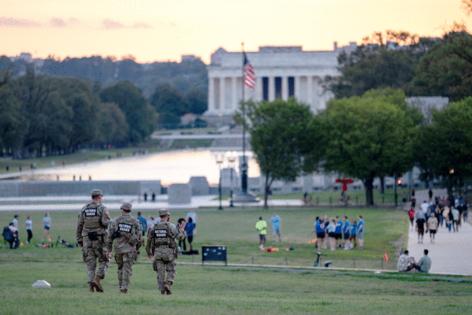Commentary: The patrol that haunts me wasn't in Baghdad; it was in Dupont Circle
Published in Op Eds
I know the look of an armed patrol. I’ve seen it in Baghdad, in Syria — in streets where fear ruled and peace was fragile. I never expected to see that same look on the subway in our own capital.
Traveling from my home in Northeast D.C. to Dupont Circle, I passed several pairs of National Guard soldiers in full gear — at stations, on trains and patrolling sidewalks. Some carried sidearms. One caught me looking and waved with an antagonistic grin. I stopped, showed him my military ID and spoke with him. We talked briefly about what it means to be a professional in uniform, about how the Army is judged not only by its strength but by its restraint.
I reminded him that the most important weapon a soldier carries in a city like this isn’t on his hip — it’s the trust of the people around him. He nodded politely, but as I walked away I wondered how much that message could stick when the mission itself pushes these young men and women into roles they were never trained for.
Dupont Circle isn’t some remote corner of Washington. It’s a hub — lined with embassies, think tanks, coffee shops, bookstores and crowded sidewalks. On any given day, you’ll find students debating politics over lattes, diplomats heading to meetings and activists gathering in the park that anchors the neighborhood. It’s a crossroads of international ideas and local community life. To see armed soldiers patrolling there is to see force imposed on a place built for conversation, exchange and civic trust.
I’ve been shot at in Iraq, led convoys through deserts scarred by war and spent nearly five years of my life on operations in the Middle East. Through it all, what unsettled me in those places was the fragility of trust between armed patrols and the civilians around them — the uneasy sense that one spark could undo any tenuous stability. I never expected to feel that same fear, not for myself, but for our society, while riding the D.C. Metro.
This Sunday, I retired as a command sergeant major. In nearly three decades of wearing the uniform, I never carried a government-issued weapon into civilian spaces in the States. Even convoys between installations were tightly regulated. Civilians didn’t see us walking into Krispy Kreme or boarding public transit with pistols on our hips. What I saw last week didn’t resemble the disciplined Army I know.
That should unsettle us.
While no doubt these Guardsmen are proud patriots, they aren’t seasoned veterans. Most are teenagers, far from home, trained for battlefield tasks but not for the unpredictable realities of a major city. In D.C., much like most large cities, you don’t just encounter commuters. You encounter people in crisis — homelessness, addiction, untreated mental illness. A local might avert their eyes or walk around. But what happens when the person in crisis steps aggressively toward an 18-year-old with a pistol on his hip and limited training in de-escalation?
The risk is not abstract. Police officers are trained for these situations because they encounter them every day. A homeless man shouts in someone’s face. A woman in distress resists an order. A soldier, out of his depth, is all but certain to misread the moment and reach for his weapon. The spark becomes a blaze, and trust between citizens and the military burns with it.
I do not question the courage or commitment of these Guardsmen. I’ve fought beside them in combat and know their grit. But I also know their limits. Asking them to police a city is unfair — to them, and to the people they’re supposed to serve.
This is not what the Guard was built for. Its mission is to respond to disasters, provide logistical support and back up civil authorities — not to serve as an armed show of force on city streets. Yet that is how they are being deployed in the nation’s capital, as they were in Los Angeles earlier this summer.
The sight of troops with weapons patrolling sidewalks, boarding trains and standing post outside coffee shops has now spread from the nation’s second-largest city to the nation’s capital. What was once extraordinary is quietly being treated as routine.
That should alarm us all.
The sight of soldiers with weapons patrolling D.C. and Los Angeles streets should feel jarring. Because once we accept it as normal, we begin to accept the very thing our military has always fought against — the idea that legitimacy comes from the barrel of a gun.
I’ve seen what that looks like in failed states abroad: checkpoints that divide neighborhoods, convoys that intimidate civilians, armed patrols that blur the line between protector and occupier. Those societies didn’t collapse overnight. They eroded slowly, as citizens became accustomed to soldiers carrying out tasks once reserved for police or community leaders. By the time people realized the cost, trust was gone.
That is not the America we should become.
For 28 years, I wore the uniform with pride. I deployed multiple times, led soldiers in combat and believed our service meant something larger — that we were defending a way of life rooted not in fear, but in freedom. As I take off the uniform for the last time, my greatest worry is that by placing young soldiers in impossible positions, we are undermining the very trust between society and service members that holds our democracy together.
The powder keg is real. And the sparks are already here.
____
Command Sgt. Maj. Eric Chastain is an adjunct professor at USC’s campus in Washington, where he teaches social analysis. He served as the Army’s first senior enlisted advisor in the White House.
©2025 Los Angeles Times. Visit at latimes.com. Distributed by Tribune Content Agency, LLC.
























































Comments